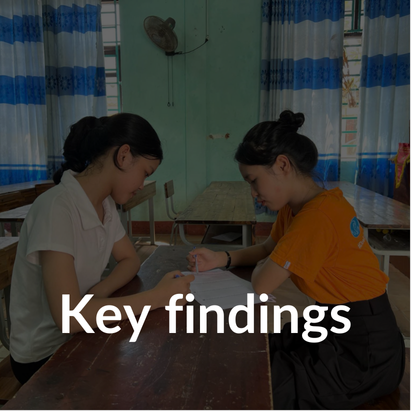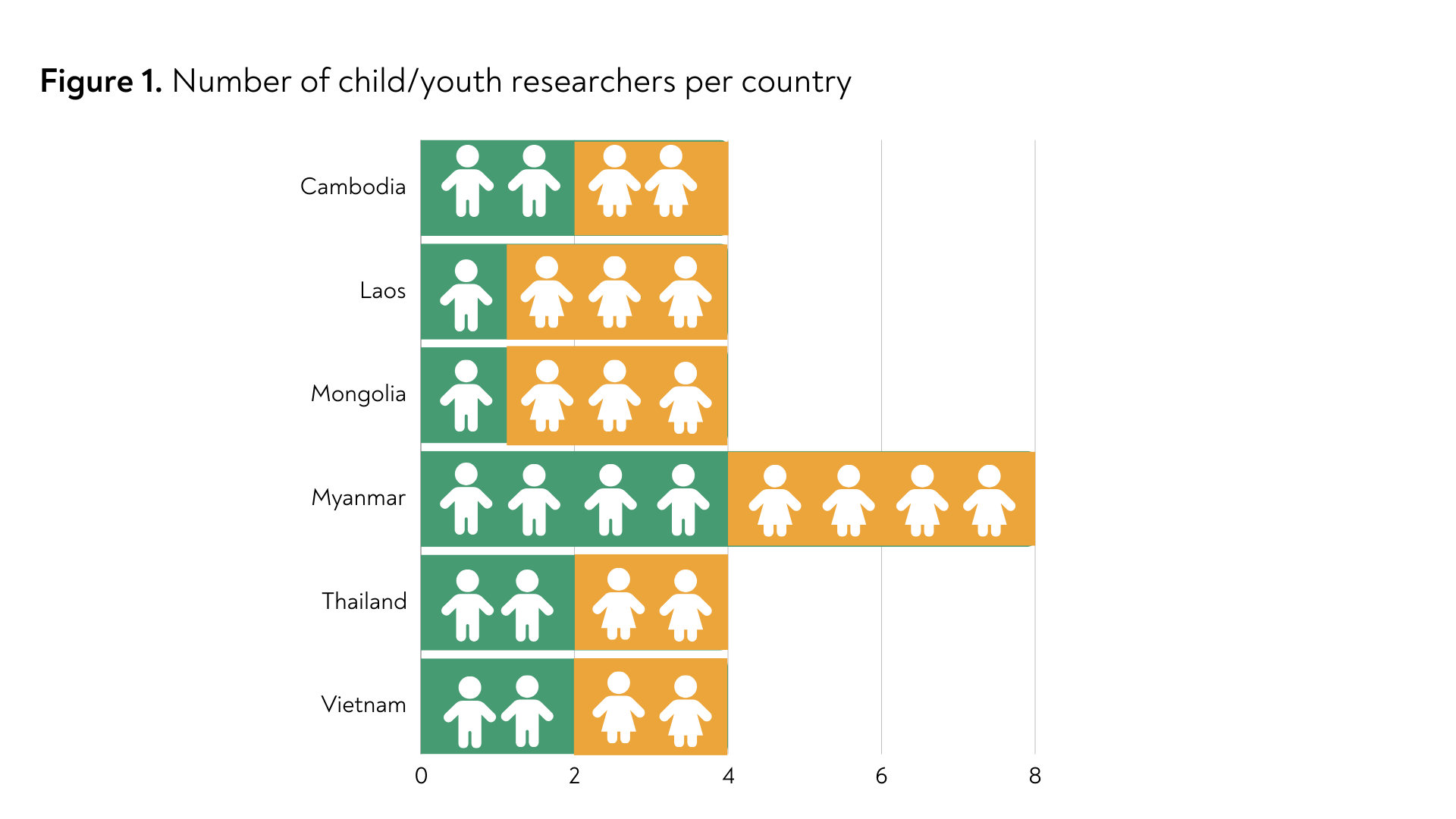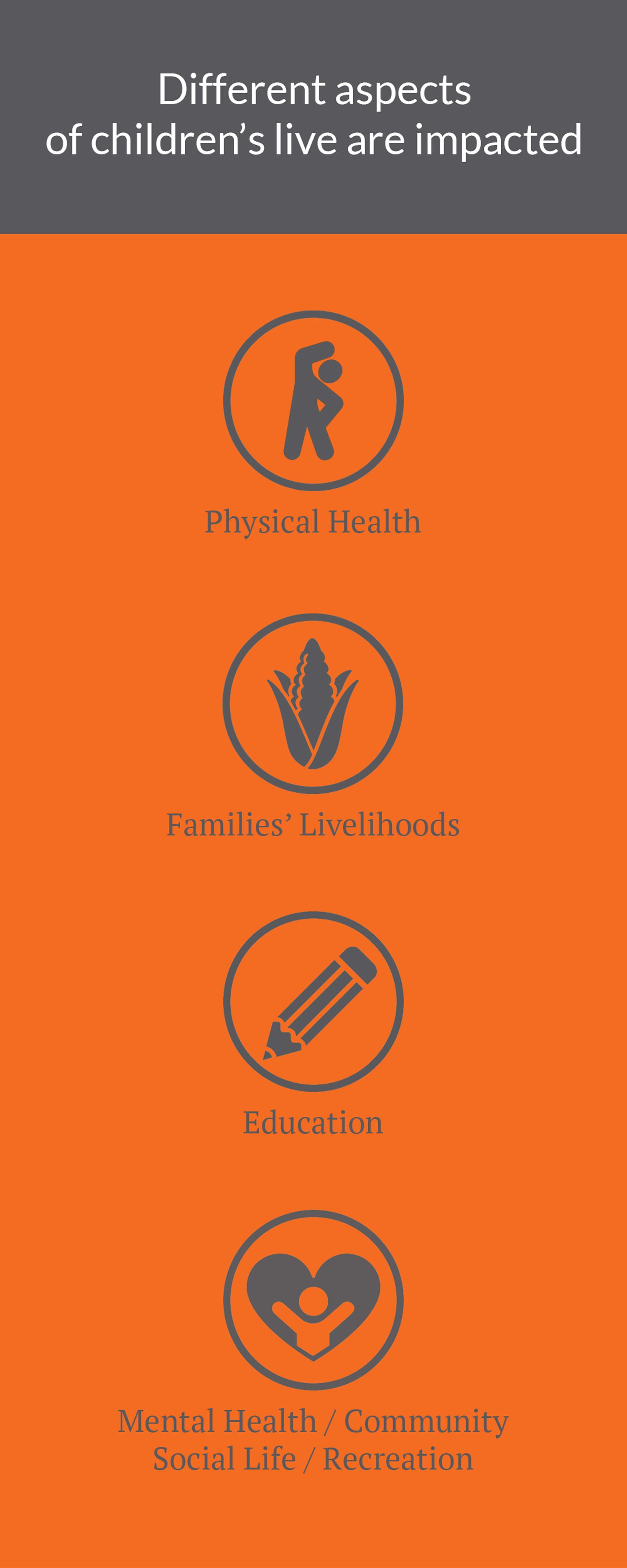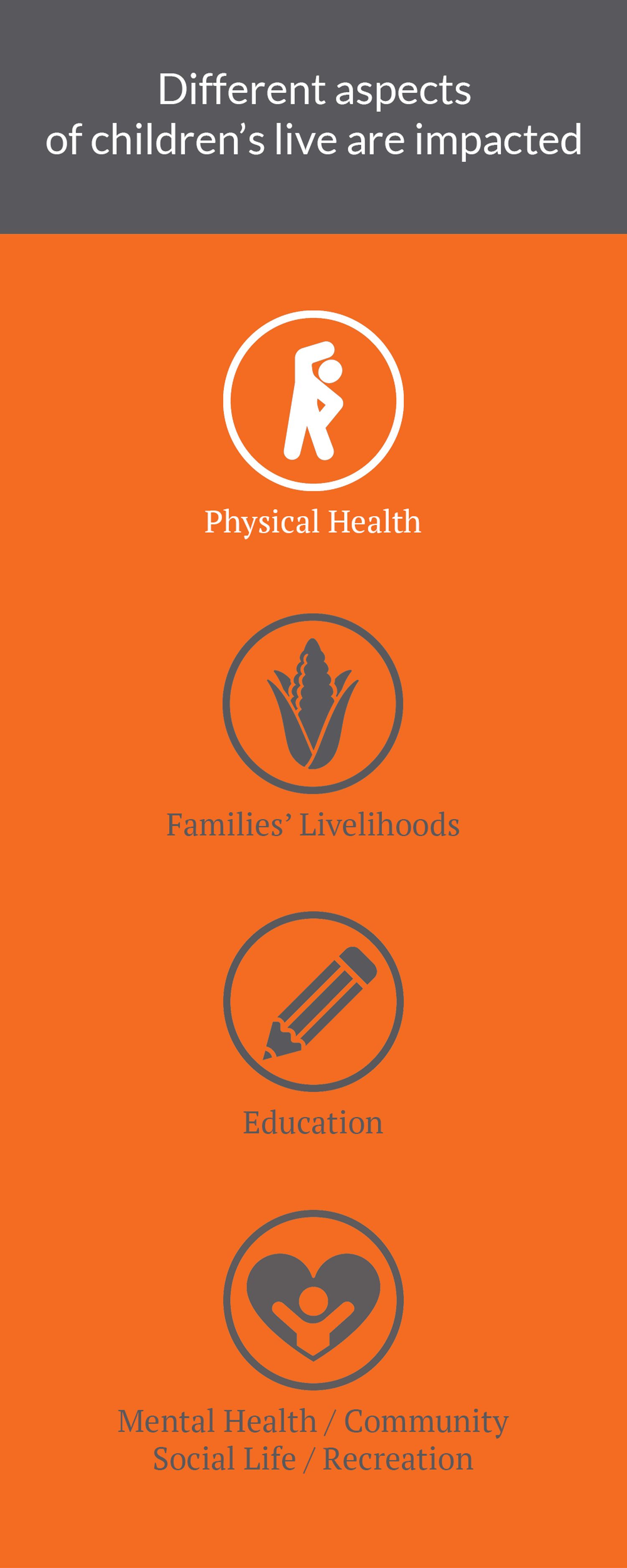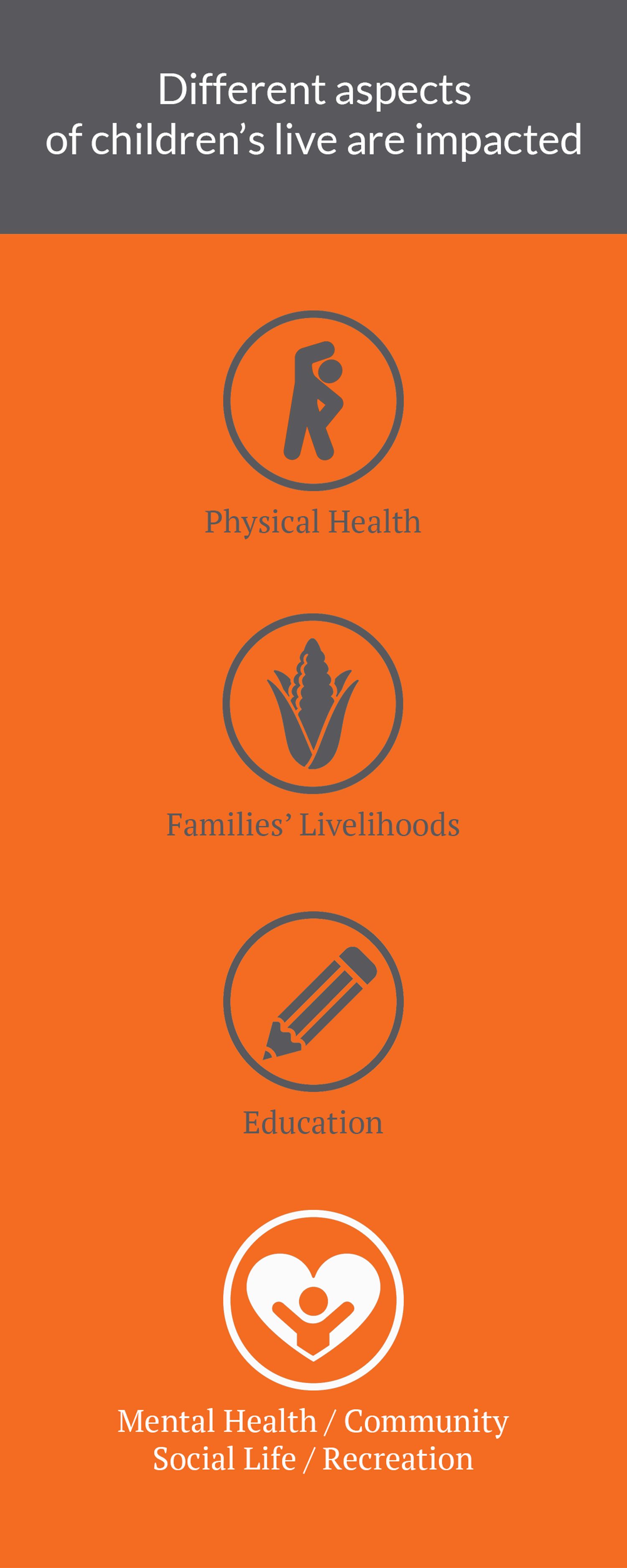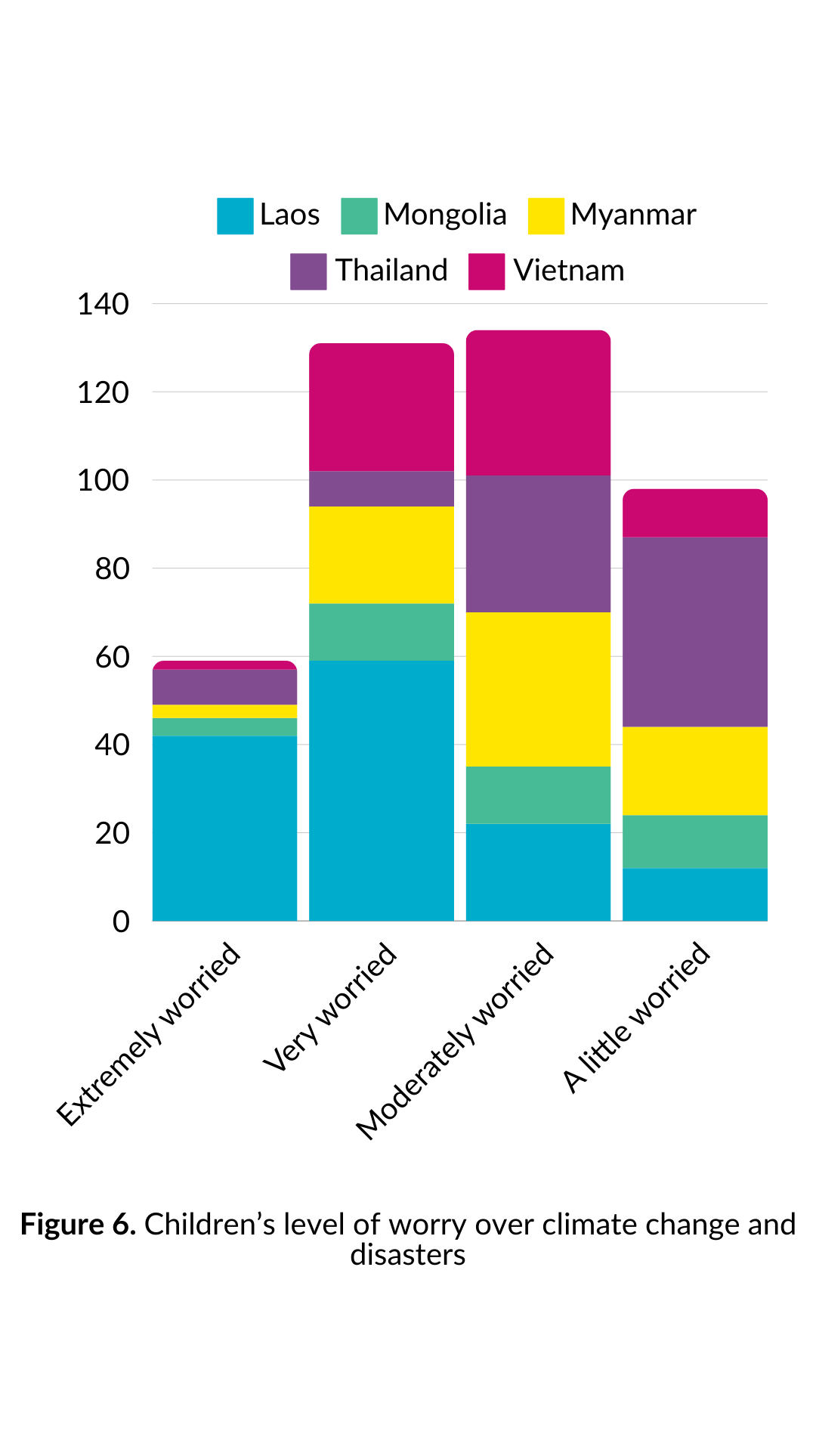Young Minds Shaping Climate Action & Disaster Mitigation for a Sustainable Future
Child-Led Study on the Lived Experiences & Perspectives of Children in East Asia

Context
East Asia, home to over 354 million children, is the most disaster-prone region in Asia Pacific. Between 2016 and 2021, 19 million children were displaced due to severe flooding, storms, and droughts. Recently, Vietnam, Myanmar, Laos, and Thailand were hit by Typhoon Yagi. In the first quarter of this year, 243 million children faced health risks from extreme heat waves.
In Cambodia, Laos, Vietnam, and Thailand, heavy rainfalls and extreme heat are major threats, while Mongolia suffers from desertification and air pollution caused by extreme cold. Vietnam also experiences landslides from prolonged rains.
UNICEF’s 2021 report highlights that East Asian countries have high Children's Climate Risk Index (CCRI) scores, exposing children to risks like poverty, malnutrition, disease, and disrupted education.

Objectives
Our main aim in our research is to get a better understanding of the impact of climate change and disasters in our communities. We also want to understand how children feel about climate change and disaster risks and what their ideas are on how the impacts of extreme weather events and disasters could be mitigated. We believe it is crucial to better understand these matters so we can work together to protect children from the harmful effects of climate change. Even if only in part, we hope to find ways to address these challenges. This is not only an issue that affects our daily lives but also deeply impacts the physical and mental development of each child, which is why we hope that our research will be helpful to our peers and the adults in our communities.
Specifically, we wanted to gain a better understanding of the following:
• The climate change and disasters children in our communities have personally experienced in recent years
• The impacts of climate change and disasters on different aspects of their lives
• Their current level of knowledge or awareness of climate change and disasters
• Their level of preparedness for disasters
• Their sources of information and preferred information platforms
Methodology
The research was conducted by 28 child researchers (ages 12-18) from Cambodia, Laos, Mongolia, Myanmar, Thailand, and Vietnam. These young researchers were trained in child-led research methods and data collection to assess the impact of climate change on their communities.
᯽ Training & Preparation
In June 2024, the researchers attended a workshop in Bangkok, where they learned how to design surveys, conduct interviews, and facilitate focus group discussions (FGDs). This was followed by online Zoom meetings to finalize the research plan. Ethical and safeguarding protocols were established to ensure participant safety.
❉ Data collection process
From July to August 2024, the team collected data from 674 children (ages 8-18) and 59 adults in disaster-affected communities:
• Laos: Online and in-person surveys with 163 children via KOBO.
• Cambodia: FGDs and interviews with 68 children and 29 adults.
• Mongolia, Myanmar, Vietnam, and Thailand: Mixed methods combining surveys and FGDs, with hundreds of participants in each country.
✧ Tools & Data Analysis
Researchers used both paper-based and digital tools. KOBO and Google Forms were used for online surveys, generating charts and graphs. Thailand, Vietnam, and Mongolia tallied responses in Excel. A saturation grid was used to identify dominant responses and highlight key quotes from interviews and FGDs.
Figure 2. Number of child/adult participants in the child/youth-led research across seven countries.
The FGD participants, are parents and community leaders, and some are chairman and representatives from the governor's council, social workers, policy specialists, and legal specialists. Of the participants, 6 were male and 14 were female.
Cambodia: The four child researchers conducted interviews and FGDs with a total of 97 participants coming from three provinces: Kampong Chhanang, Banteay Meanchey and Kampong Thom. 68 of them are children while 29 are community leaders, teachers, parents and other community members
In terms of gender, 63 of the participants are females and 34 are males. In terms of age, the 69 child participants are ages 8 to 17 years.
Laos: The four child researchers conducted a paper-based survey and online survey through KOBO Toolbox among a total of 147 children coming from four schools across four villages in Sam Neua District, Houaphanh Province.
In terms of gender, 64 of the participants are females while 83 are males. In terms of age, four of the participants are ages 8 to 11 years, 140 of them are ages 12 to 17 years, and three participants are ages 18 to 25 years.
Mongolia: The four child researchers engaged with a total of 100 participants. They conducted a paper-based survey among 80 children and FGDs among 10 child leaders and 10 community leaders. The participants come from Songinokhairkhan (urban) and Tuv Area Program (rural).
In terms of gender, 53 of the survey respondents are females while 27 are males. In terms of age, 19 participants are ages 8 to 11 years while 61 participants are ages 12 to 17 years. 50 of the participants come from the rural area while 30 of them come from the urban area.
Myanmar: The eight child researchers engaged with a total of 137 participants. They conducted an online survey via Google forms among 81 children and FGDs among 36 children and 20 community leaders. The participants come mostly from the Yangon province and a number are from the provinces of Mandalay Mon, Magway, Ayeyarwaddy.
In terms of gender, 89 of the participants are females while 48 are males. In terms of age, five participants are ages 8 to 11 years, 76 participants are ages 12 to 18 years.
Thailand: Thailand, the four child researchers engaged with a total of 120 participants. They conducted a paper-based survey among 100 children and interviews among 20 youth and community leaders coming from four provinces: Chiang Mai in the North, Kanchanaburi Province in the Central region, Bueng Kan Province in the Northeast region and Phang Nga Province in the South.
In terms of gender, 64 of the participants are females while 36 are males. In terms of age, one participant is aged 8 to 11 years, while 102 participants are aged 12 to 17 years.
As for their interview participants, 12 are youth and 8 are adults, including 2 school directors, 3 community Leaders, and 3 teachers.
Vietnam: The four child researchers engaged with a total of 116 participants. They conducted a paper-based survey among 100 children and interviews among 16 children and community leaders coming from Dak R'Lap, Hai Lang, Muong Cha, and Son Tra districts. The child participants are ages 8 to 17 years.
Key Findings

Key Finding 1:
Children experience extreme and unpredicted weather patterns
Overall, the majority of the respondents reported experiencing extreme and unpredictable weather patterns and water-related disasters including heavy rainfalls, flooding, landslides, extreme heat and drought in recent years. Meanwhile, from the quantitative surveys in five countries alone (Laos, Mongolia, Myanmar, Thailand, and Vietnam), garbage problems, air pollution, heavy rains and extreme heat are the issues that were the most cited by the participants. Severe flooding, landslides, and drought were also more salient in the interviews and FGDs which were conducted in Cambodia, Mongolia, Myanmar, Thailand and Vietnam, while Thai participants also mentioned food scarcity due to land degradation and low agricultural productivity.
Figure 3. The most significant climate change problems and disasters children experience.
• 1 in 2 children who participated in the survey in Laos reported experiencing heavy rains.
• 53% of Mongolian survey respondents and 72% of Burmese respondents said that garbage problem is the most significant issue in their communities.
• 72% of survey respondents in Myanmar said that garbage problem is the most significant issue in their communities.
• 55% of Thai survey respondents and 18% of Vietnamese survey respondents said that air pollution is the most significant issue in their communities.
“This year, the extreme heat has lasted a long time and has had serious effects, leading to plant and animal deaths, low family income, and insufficient food consumption. Moreover, I can’t travel out of my house or go to school because of the heat wave. The extreme heat harms children’s health, especially some children who have had to suspend school due to high temperatures”.
Female child club leader, 16 years old, Kampong Thom province, Cambodia
"My friend died when a landslide buried him while he was riding his motorcycle to school during the rainy season."
Female participant, 18, Laos
“Floods, including flash floods, have been on the rise. As a result, houses are getting flooded, and power outages are becoming more common during heavy rainfalls.”
Namkhaidorj, 16-year-old male participant, Mongolia
“Every year during rainy seasons, there are floods in our area and it usually lasts about 1-2 months. Our village faces this problem yearly. Our house becomes flooded and some of us have to go to monasteries as a temporary shelter. Many children face water-washed diseases at these times too.”
Amarapura, FGD participant, Myanmar
“The village's waste management is not good enough. There are no garbage pits. People who are inconsiderate will throw their trash on the side of the road, which causes the problem of garbage all over the community.”
17-year-old male participant from the North, Thailand
“The problem of smog, PM 2.5 dust and hot weather. The accumulated smoke and dust make the air worse and worse.”
16-year-old male participant from the North, Thailand
"Climate change and natural disaster issues include storms, irregular weather, and floods. Storms usually last for half a month or up to 20 days. They typically happen in October and November every year."
Female, 14 years old, Hai Lang, Vietnam

Key Finding 2:
Different aspects of children’s lives are impacted by climate change and disasters
The aspects of children’s lives that have been most heavily impacted by climate change and disasters are their physical health, their family’s livelihood, their mental health and their education. In Vietnam, participants also noted that their social/community and family life and recreation is also affected. Lao participants also reported experiencing disruptions to their recreational activities while Burmese participants mentioned having interrupted community/social lives.
"The extreme heat caused me to experience fever, cough, and dizziness. The heat also affects our health, causing us to experience flu more frequently, and makes us feel uncomfortable in the classroom because it is too hot.”
FGD participant, Kampong Chhnang province, Cambodia
“The drought made it difficult for me to maintain hygiene during menstruation. I even had to buy bottled water to clean my menstrual blood.”
FGD participant, Indonesia
“Every year during the rainy seasons, there’s floods in our area and it usually lasts about one to two months. Our village faces this problem on a yearly basis. Our house becomes flooded and some of us have to go to monasteries as temporary shelter. Many children face diseases at these times too.”
Hanni, 13, Myanmar
"During the winter, when temperatures drop to extreme lows, families burn coal in order to heat their homes. Unfortunately, this leads to a significant increase in air pollution and impacts the health of children.”
Erdenesuren, 16, Mongolia
"Due to the extreme heat, crops die and delays agricultural work, leading to food shortages for some children's families. Because of the extreme heat wave, our family cannot plant or raise livestock. It led to low family income, a lack of food supply, and affected our family members' health.”
FGD participant, Cambodia
“Because of the off-season flood, our family has lost the rice crop. So there is not enough food to eat...”
Male participant, 13, Vietnam
“It has a very heavy impact. The heavy rain has deprived my family of income because it has damaged the rice fields and we cannot cut the rubber.”
Female participant, 6, Northeast region, Thailand
“Due to the harsh winter, some classmates missed school because they lacked warm clothes, which also prevented them from avoiding some infectious diseases.”
Munkherdene, 14-year-old male participant, Mongolia
“We couldn’t continue our education for months because our whole village was flooded.”
Nyein, 17, Myanmar
“I feel worried about my future. I don't know if I can continue to go to school or not?!”
13-year-old participant, Vietnam
“The problem of wild water flowing has caused the route to be closed, and people in the community cannot travel. Children can't come to school.”
16-year-old male participant, Central Region, Thailand
“We feel stressed and we can’t sleep well because it’s often dangerous.”
Thant, 14, Myanmar
“The effect of the very hot weather is that sometimes you can't go out at all because it's so hot that you feel like your skin is burning.”
16-year-old female participant, Northern region, Thailand
“I have allergies, every time there is pollution, I get sick and I can't go out and live a normal life, both going to school and meeting friends.”
17-year-old female, Central Region, Thailand
Key Finding 3
Children self-reported moderate level of understanding/awareness of climate change and disaster impacts
The general trend based on both survey and interview/FGD findings is moderate level of knowledge on climate change and disaster impacts, with most respondents rating their knowledge as 5-7 out of 10. In Mongolia, however, the majority of children responded rated their knowledge as 3 out of 10. The child researchers from Mongolia also said that they noticed that children are concerned about climate change but they do not know what to do and have little information about disasters, indicating a need to improve their knowledge on the climate crisis.
Figure 5. The children’s self-reported level of knowledge on climate change and disasters (0 being no knowledge and 10 being very knowledgeable).

Key Finding 4
Children express moderate concern over climate change and its threat to their lives
Most participants are moderately worried about climate change and disasters. The children and youth’s anxieties or worries pertain to how climate change and disasters threaten different aspects of their lives.
Survey Insights:
• Laos: 40% are very worried.
• Myanmar: 43% are moderately worried.
• Mongolia: 13% are moderately worried.
• Vietnam: 33% are moderately worried.
• Thailand: 43% are a little worried.
“I feel afraid because the disasters are becoming more serious each year”
“I feel worried about my future. I don't know if I can continue to go to school or not?”
Emotional Reactions
Children expressed a range of emotions, from fear and anxiety to occasional optimism. In Cambodia, many feel sad about the loss of nature. One participant shared, “I feel sad because animals and plants are dead.”
In Thailand, some children still hold hope, with a 17-year-old stating, “I feel sad but not hopeless, because I think we still have solutions that can help make it better.”
The Need for Deeper Understanding
Children’s emotions often reflect their level of awareness. A 14-year-old in Vietnam noted, “We think we can work with everyone to improve this problem. However, according to my observation, there are some who are still not interested in this issue. Because they lack knowledge and lack confidence.”
Understanding climate change more deeply could lead to greater engagement and action among youth.
"I’ve been trained by the World Vision Foundation of Thailand to respond to disasters in school."
17-year-old
Central, Thailand


Key Finding 5
Children’s level of preparedness for disasters remains low to moderate
Children across East Asia report varying levels of disaster preparedness:
Figure 8. The children’s self-reported level of preparedness for disasters.
Preparedness Levels:
• Laos (26%), Myanmar (30%), Thailand (24%), and Vietnam (14%) rated themselves as moderately prepared (5-6 out of 10).
• Some participants in Vietnam, Laos, and Thailand rated themselves 10/10, while most in Mongolia (25%) rated themselves 3/10, indicating low preparedness.
Training & Family Plans:
• In Laos, Mongolia, Myanmar, Thailand, and Vietnam, many children received disaster preparedness training in school, with 69 children across these countries reporting they had no training at all.
• In Cambodia, most children had preparedness training in school and community clubs, with some having family emergency plans and evacuation drills.
• With many children still untrained in disaster response, there's a clear need to expand preparedness activities in schools and communities.
Figure 9. Tools or training children have/had in preparation for disasters.
Key Finding 6
Children are practicing climate action and mitigation measures
Top Practices:
• Planting trees, proper garbage collection, and avoiding plastic bags were the most impactful practices reported by children.
• Myanmar & Laos: Awareness-raising activities were highlighted.
• Laos & Thailand: Children emphasized organic food and energy efficiency.
• Vietnam: Walking and using public transportation were common.
Personal Contributions:
Children are actively practising:
• Walking, using water efficiently, and reducing energy use.
• Mongolia & Vietnam: Using public transport.
• Cambodia: Riding bicycles to reduce pollution.
Figure 10. Mitigation solutions that children perceive have big impacts.
“My contributions to climate change are planting vegetables and planting trees. People in the community grow some fruits and vegetables at home through reduced chemical farming and more organic farming.”
FGD with children ages 12-17 in Kampong Thom province, Cambodia
“I go to school by bicycle to get rid of pollution instead of motorcycles to reduce climate change. Children in the community participate in garbage collection on a regular basis, and this group of children regularly collects garbage on the streets, schools and public places.”
Makara, Banteay Meanchey, Cambodia
Survey Highlights:
• Lao (65%): Avoiding plastic bags is most impactful.
• Mongolia (58%): Recycling is key.
• Myanmar (99%): Planting trees is most significant.
• Thailand (97%): Growing vegetables stands out.
• Vietnam (38%): Proper garbage collection is critical.
Figure 11. Mitigation solutions that children are personally practicing.

Key Finding 7
Children are motivated to act on climate change and disasters.
Children across East Asia are motivated to act on climate change and disasters. In Laos (38%), Mongolia (23%), Myanmar (33%), Thailand (47%), and Vietnam (49%), many expressed a strong desire to contribute to environmental efforts. In Cambodia, participants said, "I am strongly encouraged to participate in activities that contribute to climate change because I want to see the community grow."
Figure 12. The children’s level of motivation to engage in environmental activities.
Sources of Motivation:
• Love of plants: 20% of Lao, 58% of Thai, and 39% of Vietnamese participants said this drives their action.
• Future generations: 73% of Myanmar respondents cited this as their main motivation.
• Personal knowledge & wildlife: Many want to set an example for others or protect nature.
Figure 13. The children’s sources of motivation to engage in environmental activities.


“I don't want it to get worse, because I can't live anymore if it worsens."
17-year-old female participant
Northern Region, Thailand


Key Finding 8:
Children learn about climate change and disasters through multiple platforms and sources of information
Key Insights:
• Social media is the top source in Laos (76%), Mongolia (25%), and Thailand (68%).
• In Myanmar, 64% rely on TV news channels, while in Vietnam, 29% get their information from school classes.
• Cambodian, Burmese, and Mongolian participants also find children and youth clubs helpful.
Figure 14. The children and youth’s top sources of information on climate
Preferred Platforms:
• Social media: Most preferred in Laos (76%), Mongolia (34%), and Myanmar (37%).
• School classes: Favored by 57% in Thailand and 28% in Vietnam.
“Most of the children in the community always receive disaster and climate change information at school through their teacher and school books.”
Chanthoeurn, a female child aged 8-11, Banteay Meanchey province, Cambodia
Figure 15. The children and youth’s preferred platforms for learning about climate change and disasters.

“I aim to combat desertification and climate change by planting a significant number of trees. However, this undertaking requires various resources such as funding, financial support, knowledge, experience, advice, and training."
- Uuganbayar, 17-year-old, Mongolia -
Key Finding 9:
Children are leading climate action and disaster mitigation efforts, but they need more support
Ongoing Initiatives:
In Cambodia, awareness-raising activities focus on reducing plastic, replanting trees, and proper waste management.
In Mongolia, tree-planting campaigns and waste sorting systems are in place, with collaboration from NGOs and the private sector. Students also help herders through donation campaigns and participate in recycling advocacy.
In Thailand, children are involved in recycling, promoting reusable bags, and running social media campaigns to raise awareness about water conservation and tree planting.
Planned Initiatives:
• Cambodia: More disaster preparedness training and tree-planting initiatives.
• Mongolia: Constructing flood dams and enhancing tree-planting projects.
• Vietnam: Plans to protect water sources and build a green campus.
Support Needed:
Children in Cambodia and Thailand need financial resources, materials, and training to expand environmental activities. Community leaders emphasized the need for child-friendly information to help kids engage in climate action, and for financial support to sustain projects.
Recommendations

Strengthening Climate Informal and Formal Education:
Cambodia, Vietnam, Myanmar, and Laos: Community leaders should conduct more climate awareness campaigns, particularly in rural areas where children need education on the sources and effects of climate change. This can be done through schools, youth clubs, and social media platforms.
Mongolia: Schools and clubs should provide more climate education, using websites and child-friendly resources to reach children effectively.
Thailand, Vietnam, and Laos: Child-friendly information on climate change should be disseminated, allowing children to better understand the issues and take action. Classes in schools should allocate more time for climate discussions, especially in Cambodia and Thailand, where children have expressed a desire for more environmental education.
Increasing Opportunities for Child and Youth Participation:
Cambodia, Laos, and Mongolia: Establish more child-led school clubs that focus on climate change education and environmental initiatives. Schools should support these clubs by giving children platforms to take leadership in local environmental projects.
Thailand: Expand youth-led environmental activities, allowing children to participate in meaningful projects that promote environmental conservation. NGOs and government bodies should collaborate on these initiatives to create long-term impact.
Mongolia: Strengthen intergenerational communication, encouraging collaboration between children and adults. Both groups are motivated to work together to implement projects that address environmental and disaster challenges.
Strengthening Climate Action and Disaster Mitigation Initiatives:
Disaster Preparedness
• Cambodia: Government and school leaders should implement disaster preparedness projects for children and communities.
• Laos: Child-focused organizations should start disaster preparedness projects for children and also involve other members of the community in these initiatives.Mongolia: Provide disaster preparedness information to children through websites and school clubs.
Disaster Risk Reduction
• Cambodia & Myanmar: Raise awareness about waste management, encouraging proper disposal practices.Mongolia: Promote waste sorting, tree planting, and plastic reuse. Build flood pipes, and ditches, and secure clean water sources with purifiers.
• Thailand: The private sector should adopt clear waste management plans focused on recycling, with transparent reporting. Government should promote research in clean energy, waste management, and sustainable technologies.
Disaster Response
• Myanmar: Create shelters in rural areas for children during natural disasters and provide medical support to those affected by climate change. Additionally, providing assistance to farmers facing livelihood losses due to extreme weather is essential for economic resilience.
• Thailand: Support farmers affected by climate change, provide medical assistance for children with respiratory issues, improve air quality in schools, and offer psychological support for students impacted by disasters.
Call to Action:
Empowering Youth for Climate Action and Disaster Preparedness
To drive meaningful change, it is crucial to strengthen climate education and advocacy through schools and community campaigns, increase disaster preparedness projects for children, and empower youth by supporting child-led environmental initiatives.
Collaboration between governments, NGOs, and schools will ensure that young people have the resources and opportunities to take action on climate change and disaster mitigation.

More Resources
This webpage was created to highlight key takeaways from our report.
For detailed sources, more information, and additional recommendations, please view the resources mentioned below.
World Vision, together with other members of the Asia Pacific Coalition for School Safety, and United Nations Major Group of Children and Youth (UNMGCY), have been working together to amplify the voices of children and youth on climate-related issues. For instance, in 2020, they co-published the report, “Guardians of the Planet”, with UNMGCY and three other major international aid organizations - UNICEF, Plan International and Save the Children. This report revealed that 77% of children and youth in the Asia-Pacific region observed an increase in climate-related disasters in their community from 2018 to 2020. 23% of children also reported experiencing extreme temperatures, and 30% faced floods or more intense rainfall.
The report, which was presented during the Asia-Pacific Ministerial Conference on Disaster Risk Reduction (APMCDRR) in Brisbane, Australia last 2022 urged the government and other stakeholders to keep the children and youth at the heart of disaster risk reduction (DRR) and climate change adaptation (CCA) policies.


